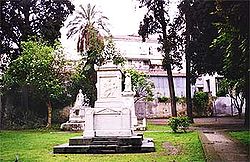- Mary Somerville
-
Mary Somerville 
Mary SomervilleBorn 26 December 1780
JedburghDied 28 November 1872 (aged 91) Nationality Scottish Fields science writer
polymathMary Fairfax Somerville (26 December 1780 – 28 November 1872) was a Scottish science writer and polymath, at a time when women's participation in science was discouraged. She studied mathematics and astronomy, and was the second woman scientist to receive recognition in the United Kingdom after Caroline Herschel.
She was the daughter of Admiral Sir William George Fairfax, and was born at the manse of Jedburgh, in the Borders, the house of her mother's sister, wife of Dr Thomas Somerville (1741–1830), author of My Own Life and Times. In 1804 she married her distant cousin, the Russian Consul in London, Captain Samuel Greig, son of Admiral Samuel Greig. They had two children before Greig died in 1807, one of whom, Woronzow Greig, became a barrister and scientist.[1]
After the death of her husband the inheritance gave her the freedom to pursue intellectual interests. In 1812 she married another cousin, Dr William Somerville (1771–1860), inspector of the Army Medical Board, who encouraged and greatly aided her in the study of the physical sciences. They had a further four children. During her marriage she made the acquaintance of the most eminent scientific men of the time, among whom her talents had attracted attention before she had acquired general fame, Laplace told her "There have been only three women who have understood me. These are yourself, Mrs Somerville, Caroline Herschel and a Mrs Greig of whom I know nothing." (Of course, Somerville was first and third of these three.)
Having been requested by Lord Brougham to translate for the Society for the Diffusion of Useful Knowledge the Mécanique Céleste of Laplace, she greatly popularized its form, and its publication in 1831, under the title of The Mechanism of the Heavens, at once made her famous. She stated "I translated Laplace's work from algebra into common language".
Her other works are the On the Connexion of the Physical Sciences (1834), Physical Geography (1848), and Molecular and Microscopic Science (1869). In 1835, she and Caroline Herschel became the first women members of the Royal Astronomical Society. In 1838 she and her husband went to Italy, where she spent much of the rest of her life.
Much of the popularity of her writings was due to her clear and crisp style and the underlying enthusiasm for her subject which pervaded them. From 1835 she received a pension of £300 from government. In 1869 she was awarded the Victoria Medal of the Royal Geographical Society.[2] She died at Naples on 28 November 1872, and is buried there in the English Cemetery, Naples.[3] In the following year there appeared her autobiographical Personal Recollections, consisting of reminiscences written during her old age, and of great interest both for what they reveal of her own character and life and the glimpses they afford of the literary and scientific society of bygone times. She also invented the commonly used variables from algebraic math.
Legacy
Somerville College, Oxford, was named after Mary Somerville, as is Somerville House, Burntisland, where she lived for a time[4] and Somerville House, a high school for girls in Brisbane, Australia. The term "scientist" was coined by William Whewell in an 1834 review of her On the Connexion of the Sciences.
Somerville Island (74°44'N, 96°10'W), a small island in Barrow Strait, Nunavut, was named after her by Sir William Edward Parry in 1819 during the first of the four Arctic expeditions under his command.
5771 Somerville (1987 ST1) is a main-belt asteroid discovered on 21 September 1987 by E. Bowell at Lowell Observatory Flagstaff, Arizona, and named for her.
Somerville crater is a small lunar crater in the eastern part of the Moon. It lies to the east of the prominent crater Langrenus, and was designated Langrenus J before being given her name by the International Astronomical Union. It is one of a handful of lunar craters named after a woman.
Notes
- ^ Appleby, J. H. (1999). "Woronzow Greig (1805-1865), F.R.S., and his scientific interests". Notes and Records of the Royal Society 53 (1): 95–106. doi:10.1098/rsnr.1999.0065. http://www.journals.royalsoc.ac.uk/content/d62hwdv3gc2d7ah9/fulltext.pdf. Retrieved 2007-08-19.
- ^ Freeman, T. W. (1966), "Baker, J.N.L. The history of geography", Cahiers de géographie du Québec (Erudit) 10 No 20: p. 352, http://www.erudit.org/revue/cgq/1966/v10/n20/020647ar.pdf, retrieved 2009-06-26
- ^ Giancarlo Alisio, Il Cimitero degli Inglesi, Naples, 1993, ISBN 8843545205
- ^ Somerville House
References
- Somerville, Martha. Personal Recollections, From Early Life to Old Age, of Mary Somerville. Boston: Roberts Brothers, 1874. (written by her daughter) Reprinted by AMS Press (January 1996), ISBN 0-404-56837-8 Fully accessible from Google Books project.
- Neeley, Kathryn A. Mary Somerville: Science, Illumination, and the Female Mind, Cambridge & New York: Cambridge University Press, 2001.
- Fara, Patricia (Sep. 2008). "Mary Somerville: a scientist and her ship". Endeavour (England) 32 (3): 83–5. doi:10.1016/j.endeavour.2008.05.003. PMID 18597849.
External links
- "Mary Fairfax Somerville", Biographies of Women Mathematicians, Agnes Scott College
- O'Connor, John J.; Robertson, Edmund F., "Mary Somerville", MacTutor History of Mathematics archive, University of St Andrews, http://www-history.mcs.st-andrews.ac.uk/Biographies/Somerville.html.
- Mary Somerville, an article by Maria Mitchell, Atlantic Monthly 5 (May 1860), 568-571.
- Mary Somerville's Biography – by M.T. Bruck, Journal of the British Astronomical Association, vol.106, no.4, 201-206.
- Women in Science
- Bibliography from the Astronomical Society of the Pacific
- Archival material relating to Mary Somerville listed at the UK National Register of Archives
Categories:- 1780 births
- 1872 deaths
- 19th-century mathematicians
- Scottish science writers
- Scottish astronomers
- Scottish mathematicians
- Women mathematicians
- Scottish translators
- People from Jedburgh
Wikimedia Foundation. 2010.

